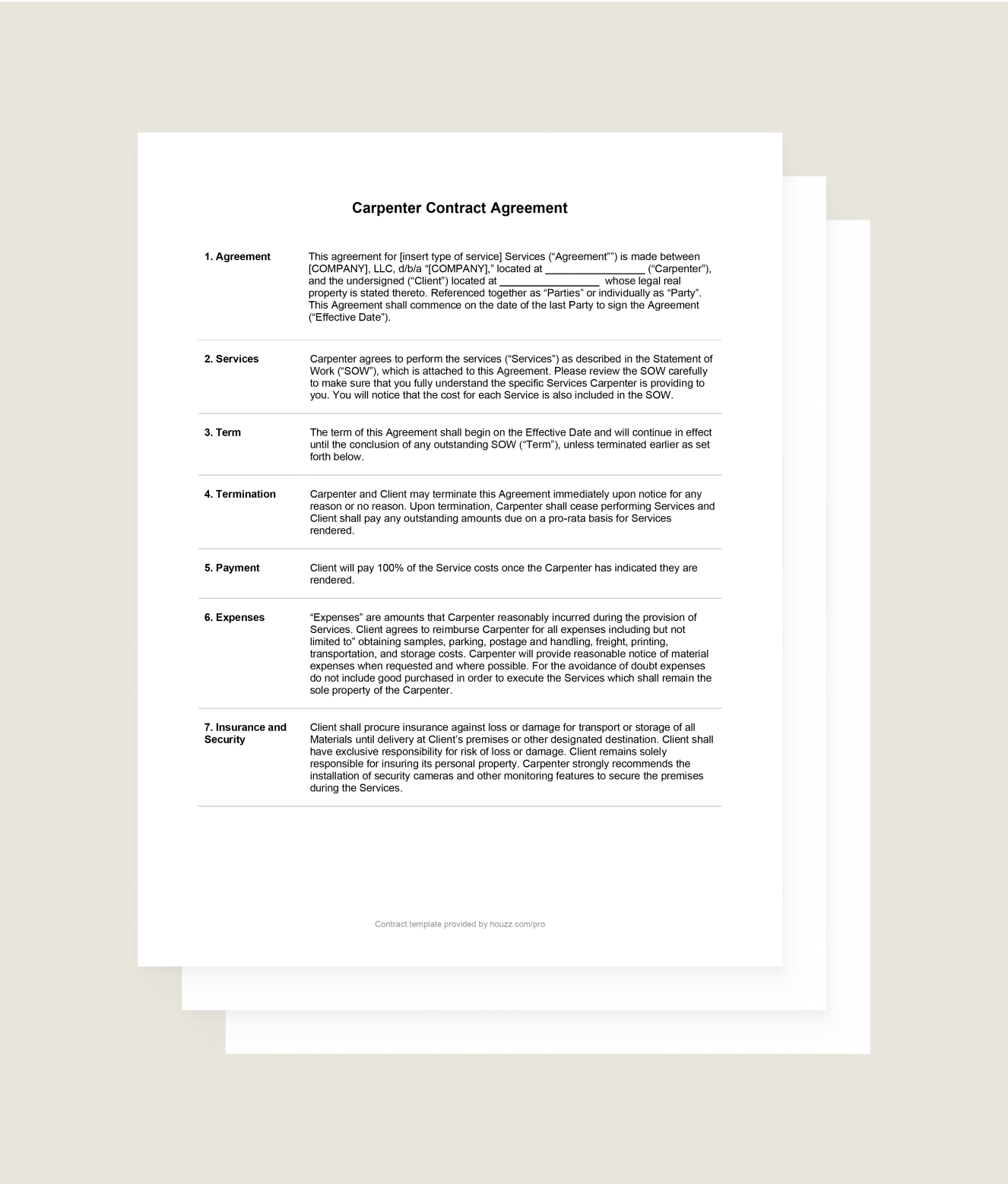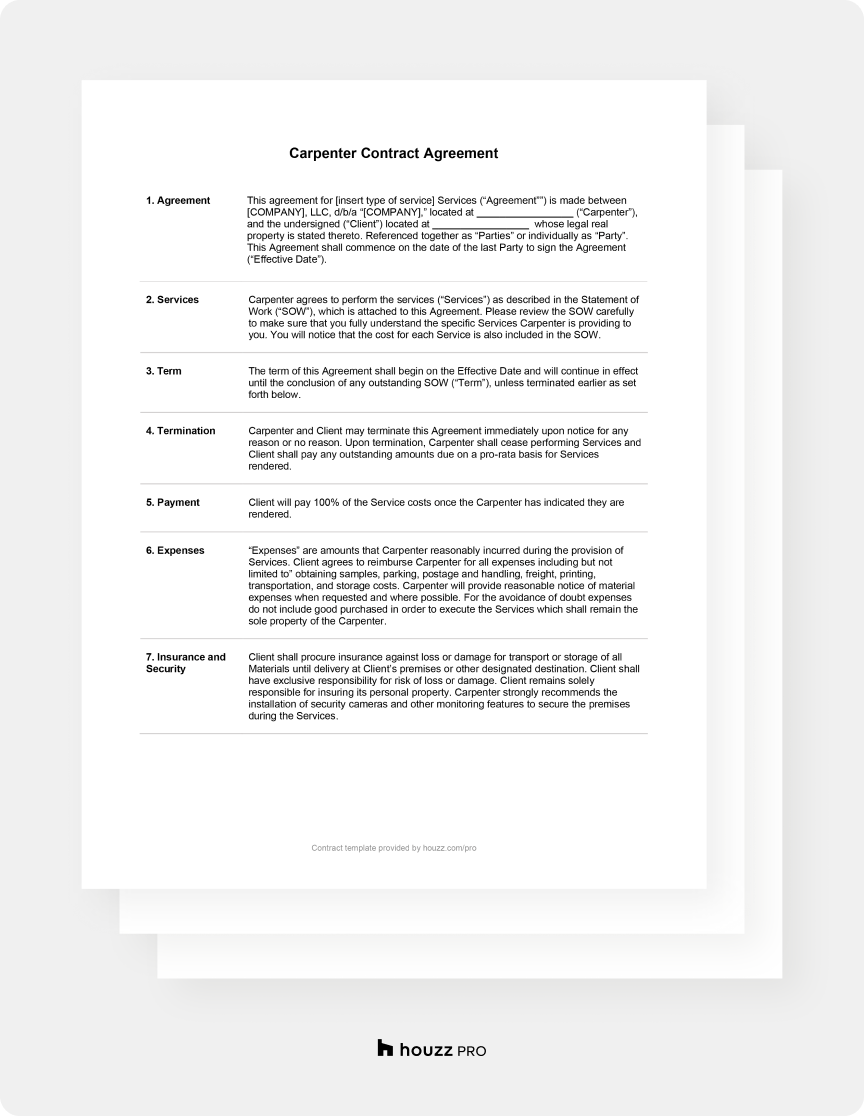Free Template: How to Write a Contract for Carpentry Work
Protect the business you've worked hard to build. Download our free carpenter contract template for carpentry work available in PDF or Word.

Are you a carpenter looking to secure more jobs and protect yourself legally? One of the most important tools in your arsenal should be a carpenter contract template or agreement. As a skilled craftsman, it's essential to have a solid contract in place before starting any project to ensure clear communication, outline expectations, and provide legal protection for both you and your clients. In this blog post, we'll discuss some tips for creating a thorough and effective carpenter contract agreement that will benefit both parties involved.
In this article, we will walk you through every step of creating a contract for carpentry work. We also include a free downloadable and fully editable carpentry contract template to get you started.
Click on a link below to jump to the section you’re most interested in:
- Download our free carpenter contract template
- What is a carpenter contract agreement?
- Why are carpentry contract templates important?
- When do you need a contract for carpentry work?
- Types of carpenter contract agreements
- 19 Clauses to include in a carpenter contract template
- How to draft a carpenter contract template
- Tips for after you’ve drafted your carpentry contract template
Download our Free, Printable Carpentry Contract Template

Here's a Carpenter Contract Template on Us!
Customize this Carpenter Contract Template to protect your business.
With so many moving parts of starting your carpentry business, it is hard to keep track of everything. This is especially true for the administrative tasks that accompany running a business. Still, one of the most important of those elements is drafting a professional and detailed contract. Running a carpentry business can be a rewarding endeavor, but it also comes with a lot of administrative work that can eat up valuable time. Thankfully, there are tools and resources available to help ease the burden of these tasks and allow you to focus on what you do best: carpentry.

Our template can help you get started because it guides you through what needs to be included in a contract, and provides an example of a carpentry contract. Besides templates, there are other ways to run your business more efficiently. Carpenter software lets you offer your clients easy to sign e-signatures for your contracts, and provides cloud storage of all your documents.
That way you can avoid keeping your documents in bulky binders and space-hogging filing cabinets. Explore our e-signature and single central business hub features with a free trial of Houzz Pro software for carpenters.

What is a carpenter contract?
A carpenter contract captures all the details of the work and services you plan to provide to your clients. It protects both you and your business as well as your clients because it keeps everyone on the same page. Also referred to as carpenter contract agreements, a carpenter contract is legally binding once it is signed by all parties, and can be referred to should questions or disputes arise later in the project.
It is more detailed than a scope of work document or a change order which details a significant change in the scope of work because it encompasses every aspect of the project, the costs, the terms and conditions and more.

Why are carpenter contract templates important?
As a carpenter, understanding the basics of a carpentry contract is crucial to ensure that your business runs smoothly and your work is protected. A carpentry contract can be a legally binding agreement between you and your client that outlines the scope of work, the payment terms, and other important details. It is a document that sets expectations and helps prevent misunderstandings or disputes down the line.
Investing in the time it takes to draft a professional and detailed contract can avoid costly change orders, and worse yet, expensive legal expenses, and work do-overs.

When do you need a carpenter contract template?
No matter the size or scope of the carpentry project, drafting a contract is a best practice that saves you money and headaches, and builds trust with your clients. That means drafting one for full remodels and deck construction, as well as minor repairs.

Types of Carpenter Contract Agreements
The type of carpenter contract agreement you create will depend on the type of pricing structure you offer to homeowners. Here are some common pricing scenarios:
- Fixed Price This sets a single price for the entire project. This lump sum covers labor, materials and all other expenses associated with the project.
- Cost Plus Under this plan, a client agrees to pay for the carpenter’s materials, labor, and any other expenses. The carpenter will be paid a percentage of the total costs or a fixed fee. The client may also add a limit stating the total construction costs may not exceed a specific amount.
- Time & Material The client pays you for materials and labor at a negotiated rate and the carpenter includes enough of a fee to cover a profit.
- Unit Pricing This is when the client agrees to pay by a unit, such as cost per square foot.

Clauses to Include in a Carpenter Contract Template
It is always advisable to seek professional legal advice to understand what clauses to include in a carpenter contract template. This assures that you and your business are protected and the clauses meet your specific needs. Here are some common details include in most contracts:
- Company & Client Information Add the details of your company and client, making sure to use the legal name for both. Brand the contract to make it look professional and uniquely yours.
- Construction Property Note where the work is being done. Reference the legal property deed whenever possible to provide clarity, and avoid questions down the road.
- Mechanics Lien In most states, a lien on property to assure payments is not legally enforceable unless the property owner is notified. State in the contract if you plan to reserve your right to employ a mechanics lien and note the conditions.
- Services List and detail all the services you are providing so that everyone is on the same page.
- Scope of Work Detail in as many specifics as possible about the scope of the work to be performed. Include any architectural plans or drawings. Note the site preparation tasks and clean up and who is responsible for what.
- Materials & Expenses This is a detailed accounting of the materials and their cost as well as any other expenses associated with the project.
- Payment Terms Note the payment provisions that the clients have agreed to, including when payments are due and any penalties for late payments.
- Construction Schedule Provide a timeline including a start and end date and any construction milestones and target dates in between.
- Permits & Licenses Don’t forget to note the permits that will be required, who is responsible for acquiring them and the costs.
- Insurance Liability insurance is required and provides clients peace of mind. Include details of your insurance and its coverage.
- Conditions & Responsibilities The section notes what conditions need to be met to start work and progress through the project and who is responsible for what aspects.
- Cancellation & Refund Under what conditions can the contract be canceled? Explain those terms, the consequences of termination and under what scenarios, a refund would be issued.
- Amendments Changes may be made to the contract and this section details the process for that.
- Governing Law To be legal, a contract must note what state and state laws will be the governing body that interprets the language of the contract.
- Dispute Resolution This outlines the procedures for resolving conflicts such as mediation, arbitration or litigation.
- Warranties Note the guarantees you provide for your craftsmanship, what it covers and for how long.
- Indemnity Carpentry work contracts typically require the carpenter to compensate (indemnify) the client for any injury or losses associated with the work or resulting from a breach in the contract. Third parties, such as other subcontractors hired by the client, may also need to be included.
- Force Majeure You are not responsible for everything that can go wrong. This states that you are not liable for damage caused by circumstances beyond your control such as natural disasters.
- Signature Terms Include a line and date for approval signatures and explain the terms that the approvers are agreeing to.

How to create a Contract for Carpentry Work Step-by-Step
A well-written contract sets clear expectations, prevents misunderstandings, and ensures that you are paid on time. Here are some steps to follow when developing your carpentry contract:
- Create a Budget The contract should include the exact cost of the carpentry project so make sure you have calculated all the expenses associated with the work, and have a quote or estimate prepared.
- Set a Schedule Determine the end and start dates of the project and target dates for various stages of the work.
- Complete Designs The design phase of the work should be completed before writing the contract so that everyone is on the same page.
- Define Provisions of Equipment & Materials Another key part of the project is determining the pricing and sourcing of the equipment and materials that will be used to carry out the carpentry work from start to finish.
- Finalize the Scope of the Work Make sure you completely understand the scope of the work and that everyone is on the same page. This may require checking back with the client to clarify and confirm their expectations of the carpentry services and work you will provide.
- Determine Payment Schedule Set the terms and stages of payment before writing up the carpentry contract.
- Draft Contract Now that you have gathered every detail of the carpentry project, it’s time to draft your contract. Add the information into the contract under each heading.
- Consult With a Lawyer Before you send a contract to a client, protect your business by seeking the advice of a lawyer to ensure that you have adequately covered all the requirements.
- Review & Send Once you are happy and confident that the contract has covered all the bases, review it one more time and then send it to your client.

What’s next? Final Tips for Creating Carpentry Contract Template
- Research State Requirements States have varying provisions and requirements regarding contracts for construction work. Check the websites of the state or states in which you are conducting business.
- Include Your License Number List your license number on the contract. It is good practice to include this information on all your business documents such as estimates, invoices and your website. Besides the legal implications, licensing signals the professionalism of your business, and adds assurance for clients.
- IMPORTANT NOTE: Seek Counsel from a Professional Lawyer To make sure your contract is legally airtight, have a lawyer review any legal language in the contract or the contract in full. Paying an attorney up front to review your contract may end up saving you money in the long run in case of disputes.
- Don’t Forget the Signatures A contract is not valid unless it is signed and dated. Make it easy for clients to sign off by providing them with the ability to sign digitally, or online.
- Store Documents Safely Devise a secure place to store the contract and all your business documents so they can be referred to in the future and to protect the privacy of your clients and your business. Consider cloud-based storage that provides security and makes it easy to organize all your documents in a single place.

Conclusion
Carpentry contracts are legal documents that protect your business and the clients you serve. Making them as comprehensive as possible can help resolve disputes that may arise during the life of the project, and can save carpenters costly litigation fees.
A carpentry contract template is a great way to learn how to draft a contract. But carpenter business software can help you keep all types of client documentation organized. From lead generation to client communication, project management to time tracking — Houzz Pro's carpenter software can help you simplify your business and maximize your profits. Explore the client communication, lead nurturing and file sharing features in Houzz Pro Carpenter software.
Learn about more ways to grow your business and run it more efficiently. Explore about How to Do a Carpenter Invoice.
The information contained in this article should not be relied upon as legal, business or tax advice. We encourage you to seek guidance from your legal counsel, business adviser or tax specialist regarding how this sample interior design contract might or might not apply specifically to your business.

Want advice delivered to your inbox?
Unlock industry insights and updates for contractors and design pros
By signing up, I agree to the Houzz Terms of Use and Privacy Policy and that Houzz may use my information to contact me about relevant content, products, and services.












Join the conversation by commenting or asking a question below. The Houzz team reads every single comment, and we’ll get back to you by email if you need us!